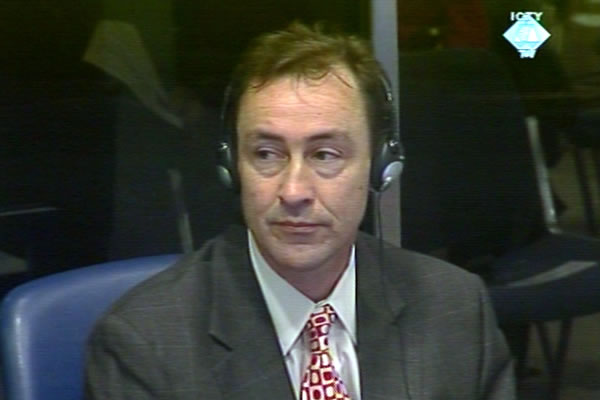Home
KARADZIC’S ‘CONTRADICTORY CLAIMS’ ABOUT THE MARKALE MASSACRES
Responding to the accused Radovan Karadzic, David Harland noted that the defense arguments about the first massacre at the Markale Town Market in February 1994 were ‘contradictory’. On the one hand, Karadzic argued that the incident was ‘staged’ and that there was no explosion, and on the other, he claimed that the shell was fired from the territory controlled by the BH Army and not from Serb positions
 David Harland, witness at the Radovan Karadzic trial
David Harland, witness at the Radovan Karadzic trial Former Republika Srpska president Radovan Karadzic elaborated today the argument he outlined in his opening statement about the first incident at the Markale town market. The indictment alleges that 66 persons were killed and more than 140 injured in the artillery attack on the Sarajevo town market on 6 February 1994. On the third day of his cross-examination of former head of the civil affairs in the UN mission in BH David Harland, the accused tried to prove that the attack was ‘staged’. ‘Mannequins’ and ‘old bodies’ of BH Army soldiers killed in combat were brought to the location, Karadzic maintained.
To prove his point, Karadzic showed a video recording of what he claimed was ‘unedited material’ from the crime scene taken on the day the incident occurred. The accused did a running commentary of the video as it played; these arguments have been heard many times in the media favoring the Bosnian Serb war leadership. Karadzic contended that a prosthetic leg, shown in the video among the bodies of dead Sarajevo residents had been brought to the town market before the incident. Karadzic argued that one of the dead bodies had been brought earlier to the Markale town market too, as it clearly displayed signs of rigor mortis. Another body is in fact a mannequin, as it is too flexible to be a human body, the accused claimed.
Harland replied that he deferred to Karadzic, a medical doctor, and hence expert for the assessment of the dead bodies’ condition. He did note that UNPROFOR staff, including doctors, military experts and the UN force commander General Rose, that arrived at the scene immediately after the explosion didn’t observe any of the phenomena the accused described. When prosecutor Edgerton said the source of the recording Karadzic showed was not identified, Karadzic said the video was taken by the BHTV from Sarajevo. However, the logo of the Serbian Radio Television from Pale could be seen on the screen.
The accused then propounded the second part of his ‘conspiracy theory’ about the Markale town market massacre. According to Karadzic, the shell was fired from the BH Army-controlled territory. To corroborate this claim, Karadzic showed some documents drafted by the UN, including a report authored by the UN Secretary General on 16 February 1994, stating that it ‘is not known which warring side fired the shell’. Harland confirmed that there was not enough ‘empiric evidence’ to establish the location from which the shells were fired. However, the witness emphasized that the Bosnian side complied with all UNPROFOR requests during the investigation, while the Bosnian Serbs prevented UNPROFOR staff from visiting locations under their control from where the shell could have been fired. This is why the UN peacekeepers were ‘a bit wary’ of the Serbs.
As the accused continued to insist that the shell had been fired from the ‘Muslim territory’, the witness at one point said that the defense case was ‘contradictory’: on the one hand, the defense claims the incident was ‘staged’ and there was no explosion, while on the other it insists the shell was fired from the BH Army-controlled territory and not from Serb positions.
Karadzic wanted to prove that from 1992 to 1995 Sarajevo was the scene of a war between two equal sides in an effort to challenge the prosecution’s allegation about VRS terror campaign. Karadzic showed a series of BH Army documents showing that they had at their disposal substantial artillery firepower and that there were ‘many legitimate military targets’ in the city. The witness didn’t even try to contest these claims, but insisted he was more concerned with something else: the fact that Bosnian Serbs did not for the most part attack military targets, but civilian parts of Sarajevo. This led the witness to conclude that the objective of the shelling was to ‘terrorize the poor, innocent population’.
David Harland, UN official from New Zealand, thus completed his four-day evidence. The trial of Radovan Karadzic continues next week with a new prosecution witness.
Linked Reports
- Case : Karadzic
- 2010-05-10 FOR KARADZIC, ATTACK IS THE BEST DEFENSE
- 2010-05-07 KARADZIC’S ‘INVERSION OF REALITY’
- 2010-05-06 ‘TURNING SARAJEVO’S TERROR TAPS’
- 2010-05-17 TRIAL CHAMBER CONCERNED OVER KARADZIC’S PROFLIGACY
- 2010-05-19 WITNESS: SARAJEVO WAS WORSE THAN BEIRUT
- 2010-05-20 KARADZIC WANTS TO SET THE RECORD ON SARAJEVO STRAIGHT
